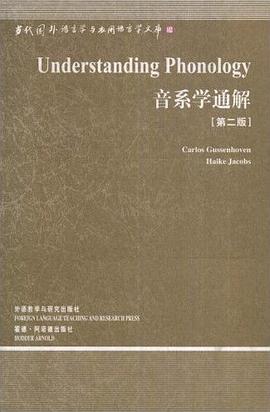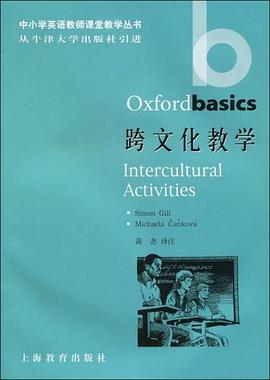
具体描述
内容简介
《音系学通解》是一部音系理论的教科书,这部教科介绍了以SPE(Cnomsky & Halle 1968)为代表的经典生成音系学至优选论几乎所有得要的音系学理论,讨论了音系学领域中许多热点问题,全书每一章都附的思考题和练习题,正文和红习题涉及一百多种语言的材料,作者精心安热排,突出重点,精选语言材料,行文简练,从而使一部二百多面的教科书包含了如此之多的内容。
生成音系学是当代音系学的主流,这部教产书介绍的理论,基本概念和分析方法主要取之于生成音系学的研究成果。
-------
目录
Preface
1 The production of speech
1.1 Introduction
1.2 The lungs and the larynx
1.2.1 The vocal folds: the open and vibrating glottis
1.2.2 Devoicing and aspiration
1.2.3 Special types of phonation
1.2.4 Pitch
1.2.5 The glottal stop
1.3 The vocal tract
1.3.1 The pharynx
1.3.2 The nasal cavity
1.3.3 The mouth
1.4 Vowels
1.5 Constrictions
1.5.1 Places of articulation
1.5.2 Types of constriction
1.6 Segmental duration
1.7 Complex consonants
1.7.1 Secondary articulations
1.7.2 Double articulations
1.7.3 Manner-contourconsonants
1.8 Nonpulmonic consonants
1.9 Stress
1.10Conclusion
2 Some typology: sameness and difference
2.1 Introduction
2.2 Morphosyntactic structure
2.2.1 Morphologicalstructure
2.2.2 Syntactic structure
2.3 A world without phonological structure
2.3.l One phonology for all languages?
2.3.2 Two kinds of structure
2.4 There's a difference
2.5 Universals and implicational relations
2.5.1 Plain or special?
2.5.2 Avoiding complexity
2.5.3 A word of caution
2.5.4 Speech ergonomics
2.5.5 System gaps
2.6 Conclusion
3 Making the form fit
3.1 Introduction
3.2 Hawaiian
3.3 Adjustment processes
3.3.1 The process of nativization
3.3.2 Adjustments in the native vocabulary
3.4 Two approaches
3.4.1 Rules
3.4.2 Constraints
3.5 Choosing between rules and constraints
3.5.1 Gradient violation and unranked constraints
3.6 Conclusion
4 Underlying and surface representations
4.1 Introduction
4.2 Allophonic variation
4.3 Two levels of representation
4.4 Neutralization
4.5 Choosing the underlying form
4.6 Conclusion
5 Distinctive features
5.1 Introduction
5.2 Motivating distinctive features
5.3 Feature values
5.4 A set of distinctive features
5.4.1 Major-class features
5.4.2 Laryngeal features
5.4.3 Manner features
5.4.4 Ambiguity and nonspecification
5.5 Place features
5.5.1 Labial
5.5.2. Coronal
5.5.3 Dorsal
5.5.4 Radical
5.6 Some examties
5.7 Redundant vS contrastire features
5.8 Conclusion
6 0rdered rules
6.1 Introduction
6.2 SPE representations
6.3SPE rules
6.3.1 Refefence to the syllable
6.3.2 The brace
6.3.3 Variable feature values
6.3.4 Parentheses
6.3.5 The transformationaI rule format
6.4 Linear order
6.5 Extrinsic and intrinsic ordering
6.6 Feeding,counterfeeding,bleeding,counterbleeding
6.6.1 Feeding order
6.6.2 Counterfeeding order
6.6.3 Bleeding order
6.6.4 Counterbleeding order
6.7 Opacity
6.8 Conclusion
7 A case study:the diminutive suffix i11 Dutch
7.1 Introduction
7.2 General Dutch rules
7.2.1 Final devoicing
7.2.2 Palatalization
7.2.3 Degemination
7.3 Standard Dutch
7.4 The dialect of Sittard
7.5 Conclusion
8 Levels of representation
8.1 Introduction
8.2 Defining an intermediate level of representation
8.3 Lexical Phonology
8.3.1 Reference to morphological labels
8.3.2 Exceptions
8.3.3 Structure preservation
8.3.4 Natire.speaker intuitions
8.3.5 ADplication across WOrd boundaries
8.3.6 Lexical rules apply before postlexical rules
8.4 Phonological information in the lexicon
8.5 Controversial properties of lexical rules
8.6 Beyond the surface representation
8.6.1 Phonetic implementation
8.6.2 Models of implementation
8.6.3 Deciding between phonology andphonetic implementation
8.7 Conclusion
9 Representing tone
9.1 Introduction
9.2 The inadequacy of a linear model
9.3 W.0rd.based tone patterns
9.3.1 Language-specific associations
9.4 Stability
9.5 Postlexical tone
9.6 The Obligatory Contour Principle
9.6.1 Violating the OCP
9.7 Conclusion
10 Between the segment and the syllable
10.1 Introduction
10.2 A skeletaI tier
10.3 Syllabification:the Maximum Onset Principle
10.3.1 The sonority profile
10.4 Arguments for the CV tier
10.4.1 The templatic use of the CV tier
10.4.2 Unfilled and unassociated slots
10.4.3 Compensatory lengthening
10.5 Moras
10.6 svllable-based generalizations
10.7 Post-MOP syllabification rules
10.7.1 Ambisyllabicity in English
10.8 Conclusion
11 Feature geometry
11.1 Introduction
11.2 Tw0 properties ofassimilations
11.3 Natural feature classes
11.4 Buildingatree
11.4.1 The place node
11.4.2 The laryngeal node
11.413 The supralaryngeal node
11.5 Spreading and delinking
11.5.1 Writing rules
11.6 Implications OfundersDecification
11.6.1 Default rules
11.7 Condusion
12 Exploiting the feature tree
13 Stress and feet
14 Further constraining stress
15 Phonology above the word
Epilogue
Key to questions
References
Language index
Subject index
作者简介
目录信息
1 The production of speech
1.1 Introduction
1.2 The lungs and the larynx
1.2.1 The vocal folds: the open and vibrating glottis
1.2.2 Devoicing and aspiration
1.2.3 Special types of phonation
1.2.4 Pitch
1.2.5 The glottal stop
1.3 The vocal tract
1.3.1 The pharynx
1.3.2 The nasal cavity
1.3.3 The mouth
1.4 Vowels
1.5 Constrictions
1.5.1 Places of articulation
1.5.2 Types of constriction
1.6 Segmental duration
1.7 Complex consonants
1.7.1 Secondary articulations
1.7.2 Double articulations
1.7.3 Manner-contourconsonants
1.8 Nonpulmonic consonants
1.9 Stress
1.10Conclusion
2 Some typology: sameness and difference
2.1 Introduction
2.2 Morphosyntactic structure
2.2.1 Morphologicalstructure
2.2.2 Syntactic structure
2.3 A world without phonological structure
2.3.l One phonology for all languages?
2.3.2 Two kinds of structure
2.4 There's a difference
2.5 Universals and implicational relations
2.5.1 Plain or special?
2.5.2 Avoiding complexity
2.5.3 A word of caution
2.5.4 Speech ergonomics
2.5.5 System gaps
2.6 Conclusion
3 Making the form fit
3.1 Introduction
3.2 Hawaiian
3.3 Adjustment processes
3.3.1 The process of nativization
3.3.2 Adjustments in the native vocabulary
3.4 Two approaches
3.4.1 Rules
3.4.2 Constraints
3.5 Choosing between rules and constraints
3.5.1 Gradient violation and unranked constraints
3.6 Conclusion
4 Underlying and surface representations
4.1 Introduction
4.2 Allophonic variation
4.3 Two levels of representation
4.4 Neutralization
4.5 Choosing the underlying form
4.6 Conclusion
5 Distinctive features
5.1 Introduction
5.2 Motivating distinctive features
5.3 Feature values
5.4 A set of distinctive features
5.4.1 Major-class features
5.4.2 Laryngeal features
5.4.3 Manner features
5.4.4 Ambiguity and nonspecification
5.5 Place features
5.5.1 Labial
5.5.2. Coronal
5.5.3 Dorsal
5.5.4 Radical
5.6 Some examties
5.7 Redundant vS contrastire features
5.8 Conclusion
6 0rdered rules
6.1 Introduction
6.2 SPE representations
6.3SPE rules
6.3.1 Refefence to the syllable
6.3.2 The brace
6.3.3 Variable feature values
6.3.4 Parentheses
6.3.5 The transformationaI rule format
6.4 Linear order
6.5 Extrinsic and intrinsic ordering
6.6 Feeding,counterfeeding,bleeding,counterbleeding
6.6.1 Feeding order
6.6.2 Counterfeeding order
6.6.3 Bleeding order
6.6.4 Counterbleeding order
6.7 Opacity
6.8 Conclusion
7 A case study:the diminutive suffix i11 Dutch
7.1 Introduction
7.2 General Dutch rules
7.2.1 Final devoicing
7.2.2 Palatalization
7.2.3 Degemination
7.3 Standard Dutch
7.4 The dialect of Sittard
7.5 Conclusion
8 Levels of representation
8.1 Introduction
8.2 Defining an intermediate level of representation
8.3 Lexical Phonology
8.3.1 Reference to morphological labels
8.3.2 Exceptions
8.3.3 Structure preservation
8.3.4 Natire.speaker intuitions
8.3.5 ADplication across WOrd boundaries
8.3.6 Lexical rules apply before postlexical rules
8.4 Phonological information in the lexicon
8.5 Controversial properties of lexical rules
8.6 Beyond the surface representation
8.6.1 Phonetic implementation
8.6.2 Models of implementation
8.6.3 Deciding between phonology andphonetic implementation
8.7 Conclusion
9 Representing tone
9.1 Introduction
9.2 The inadequacy of a linear model
9.3 W.0rd.based tone patterns
9.3.1 Language-specific associations
9.4 Stability
9.5 Postlexical tone
9.6 The Obligatory Contour Principle
9.6.1 Violating the OCP
9.7 Conclusion
10 Between the segment and the syllable
10.1 Introduction
10.2 A skeletaI tier
10.3 Syllabification:the Maximum Onset Principle
10.3.1 The sonority profile
10.4 Arguments for the CV tier
10.4.1 The templatic use of the CV tier
10.4.2 Unfilled and unassociated slots
10.4.3 Compensatory lengthening
10.5 Moras
10.6 svllable-based generalizations
10.7 Post-MOP syllabification rules
10.7.1 Ambisyllabicity in English
10.8 Conclusion
11 Feature geometry
11.1 Introduction
11.2 Tw0 properties ofassimilations
11.3 Natural feature classes
11.4 Buildingatree
11.4.1 The place node
11.4.2 The laryngeal node
11.413 The supralaryngeal node
11.5 Spreading and delinking
11.5.1 Writing rules
11.6 Implications OfundersDecification
11.6.1 Default rules
11.7 Condusion
12 Exploiting the feature tree
13 Stress and feet
14 Further constraining stress
15 Phonology above the word
Epilogue
Key to questions
References
Language index
Subject index
· · · · · · (收起)
读后感
评分
评分
评分
评分
用户评价
虽然说是Understanding,但是并不是入门级的,可能是在中级左右吧。看完以后第一件事就是倒头睡觉。
评分天啊。。。那年考试居然还得了75分。。。谢谢。。
评分痛苦中
评分书上习题很有特点
评分虽然说是Understanding,但是并不是入门级的,可能是在中级左右吧。看完以后第一件事就是倒头睡觉。
相关图书
本站所有内容均为互联网搜索引擎提供的公开搜索信息,本站不存储任何数据与内容,任何内容与数据均与本站无关,如有需要请联系相关搜索引擎包括但不限于百度,google,bing,sogou 等
© 2026 qciss.net All Rights Reserved. 小哈图书下载中心 版权所有





















